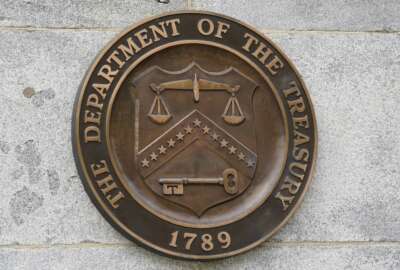‘Eye-watering kind of fraud’: Improper payments account for third of pandemic unemployment program’s funds
A Labor Department report underscores how pandemic-era programs that didn't verify the eligibility of applicants were exploited by fraudsters.
Federal agencies and their watchdogs are still getting to the bottom of the total amount of fraud across more than $5 trillion in COVID-19 emergency spending, but the Labor Department is uncovering a major source of those misspent funds.
The Labor Department, in a report released this week, estimates improper payments made up nearly 36% of spending on the Pandemic Unemployment Assistance (PUA) program between March 2020 and September 2021.
Congress authorized the Pandemic Unemployment Assistance (PUA) program in the CARES Act for self-employed individuals who weren’t eligible for regular unemployment insurance (UI) benefits at the height of the COVID-19 pandemic.
“While PUA provided critical support to workers and communities during a historic pandemic, states faced serious challenges in minimizing improper payments and stewarding federal funds in this entirely new program,” the Labor Department wrote in its report.
In the first nine months of the program in 2020, PUA allowed payments to be made based on self-certification of information, without a requirement for individuals to verify their identity.
The Labor Department paid out $131 billion in assistance in 2020, before it put stronger identity-verification measures in place the following year. At least 60% of program spending that year went out before Congress added identity verification protections.
The report underscores what federal agencies and watchdogs have long suspected — that pandemic-era programs that didn’t verify the eligibility of applicants were exploited at a particularly high rate by fraudsters and criminal syndicates.
Former PRAC Executive Director Bob Westbrooks, author of the book, “Left Holding the Bag: A Watchdog’s Account of How Washington Fumbled its COVID Test,” told Federal News Network it seems a “significant percentage” of the improper payments in the PUA program amounts to fraud.
“It is an eye-watering kind of fraud, there’s no doubt about it,” Westbrooks said. “The number doesn’t surprise me. It actually saddens me, and confirms, I think, what we’ve known for some time.”
Former PRAC Deputy Executive Director Linda Miller, founder and CEO of the Audient Group consulting firm, said in an interview that Congress envisioned the PUA program would benefit freelancers and those participating in the gig economy.
But by allowing PUA applicants to self-certify their eligibility for nearly all of 2020, Miller said lawmakers left the program wide open to fraud.
“Fraud, of course, has to be prosecuted in a court of law to be called fraud. But if somebody knows that they’re not eligible for something, and they’re applying for it anyway … it’s a fair bet that they were at least trying to get something, whether or not they knew they weren’t entitled to it,” Miller said.
The Labor Department’s report found states especially saw challenges overseeing the program and minimizing improper payments during the first nine months of the pandemic. But agencies say unemployment insurance programs have been a longtime source of improper payments.
The Office of Management and Budget, in a December 2021 blog post, found improper payments grew most under the Federal-State Unemployment Insurance program, which saw its improper payment rate reach nearly 19% — eight points higher than pre-pandemic rates.
Treasury Deputy Assistant Secretary for Accounting Policy and Financial Transparency Renata Miskell said in a recent interview that a majority of improper payments stem from federally funded, state-administered programs like Medicaid and federal-state unemployment insurance programs.
Amy Simon, former acting deputy assistant secretary for the Labor Department’s Employment and Training Administration (ETA), and founder of the consulting firm Simon Advisory, said it was a “missed opportunity” that lawmakers didn’t close the loophole allowing applicants to self-certify their eligibility until December 2020.
“I think the extent of PUA fraud was evident very early in the program,” Simon said. “The intent was, I believe, coming from a good place. But the reality is people at the time said, ‘This is going to be a problem.’ And it was, in fact, a problem.”
Labor Department Inspector General Larry Turner told the House Oversight and Accountability Committee in March 2023 that PUA’s reliance on self-certification during its first nine months made the program “extremely susceptible to improper payments, including fraud.”
Westbrooks said PRAC members in the first few months of the pandemic met with federal law enforcement officials, and were briefed by the Secret Service that international criminal organizations had filed fraudulent fraud claims in all 50 states.
“We knew from the beginning that this was global in scope. You would see that month after month — you would see cases,” Westbrooks said.
Miller said pandemic watchdogs saw organized crime rings and nation-state actors using stolen identities to fraudulent obtain pandemic funds “at a scale that I don’t think anybody was anticipating.”
For example, in July 2020, according to reporting from DCist, former Maryland Governor Larry Hogan announced the state blocked a fraud scheme of about 47,000 fraudulent claims worth about $500 million.
“That’s industrial-scale fraud from professional scammers abroad,” Westbrooks said.
‘Not connecting any dots’
While federal and state governments saw improper payments across all unemployment benefits at the height of the pandemic, Simon said states had more data available administering traditional UI payments, compared to those seeking benefits under PUA.
“When someone comes in and claims unemployment insurance, you check with their previous employer — was it this person? Did they make this much money? Did they separate from employment for acceptable reasons?” Simon said. “There’s sort of a triangle between the former employer, the worker themselves, and the state workforce agency. And that triangle provides some safety, at least double-checking some data elements within unemployment insurance.”
The PUA program, even after Congress added stronger verification steps in 2021, gave states little data to verify the identities of applicants.
“We’re talking about brand-new populations, in a lot of cases, and not connecting any dots. I honestly don’t blame states, in some cases, very early on, because they were putting the program together as people were dealing with extreme financial distress in the wake of those early days of the pandemic,” Simon said.
The Labor Department in 2020 created a UI Integrity Data Hub that allowed states to cross-reference incoming claims against data to indicate whether an applicant filed claims in multiple states, or other signs of suspicious activity.
But in 2020, only 34 of 53 state UI systems (including the District of Columbia, Puerto Rico and the U.S. Virgin Islands) were using the data hub, and many states had yet to take advantage of the data hub’s capacity to check all incoming claims for red flags.
Westbrooks said the Labor Department didn’t initially provide guidance to encourage states to use the data hub.
“That was very frustrating for a lot of us in the oversight community,” he said. “It was only after the fraud scandal broke at the national level, and we saw the depth of it, that states realized that it was to their advantage to use the system.”
Westbrooks said governmentwide use of the Treasury’s Do Not Pay service, which checks many data sources at one time to verify a recipient’s eligibility for benefits, would be the single most impactful agencies could do to reduce improper payments.
“It’s one thing to say that you use that as a tool, but Do Not Pay just flags suspected transactions. it’s still up to the agencies to clear flags,” Westbrooks said. “Sometimes what we saw in the pandemic is that even when Do Not Pay flags something as potentially fraudulent, it would still get pushed through, where the agency didn’t give appropriate due diligence to clear the flag or not.”
‘Perfect storm’ for fraud
Aside from Congress creating PUA without some basic program integrity measures in place, the Labor Department found decades of underfunded state IT systems and an unprecedented volume of UI claims “created a perfect storm” for fraud.
Westbrooks said “decades of underinvestment” in state IT systems allowed those systems to be quickly overwhelmed with a surge in applications.
Miller said states had been slow to implement the kinds of program integrity improvements watchdogs recommended for years — well before the pandemic stressed these systems to their limit.
“GAO had put reports out for 10 years or more warning that these unemployment programs, these systems were highly out of date. They were in bad need of modernization. Many of them operating on COBOL and [were] legacy IT systems, and nobody heeded those warnings,” Miller said.
Labor Department wrote in its report that it’s taken “vigorous action to strengthen the integrity of unemployment insurance systems.” Those efforts include increased identity verification, improved data sharing and more resilient IT systems.
To build on lessons learned during the pandemic, members of the Joint Financial Management and Improvement Program are planning to release a three-year Payment Integrity Plan this fall.
But in order for agencies to make a meaningful reduction in improper payments, Miller said agencies need stronger incentives to not just get money out the door, but ensure that the payments go to eligible individuals.
“When I was at GAO, we would talk to agencies, and they would say, ‘Our mission is to get these benefits into the hands of the people who need them. Our mission is not to identify fraud, waste and abuse.’ And what we used to say was, ‘No, your mission is to get these benefits into the correct hands,'” Miller said. “But that’s not how leadership looks at it. Leadership looks at it [that] as long as we get the money out, we’ve done our job. And if we don’t get the money out of this backlog, that’s when we’re going to have to show up at a hearing and answer for that.”
Stronger identity verification
With a major shift to individuals applying for government benefits online, Westbrooks said agencies would also benefit from a stronger standard for online identity verification.
“We need to advance that conversation, bring us into the modern world that some other countries have, where we’re better able to check somebody’s ID at the door when they’re coming into our IT systems, and verifying and validating that they are who they say they are,” Westbrooks said.
But individuals, he added, are wary of sharing more of their personal information online — since fraudsters are already stealing information from data breaches in and out of government.
“You can buy anybody’s personal information for the price of a Chipotle burrito and get it easily — monetize that identity and file, whether it’s unemployment insurance or other federal benefit programs,” Westbrooks said. “Until we solve that digital identity piece, I think we’re going to continue to be vulnerable.”
While agencies face a tricky balance between ease of access and mitigating fraud, Simon said program managers shouldn’t sacrifice one for the other.
“I tend to think that it’s a false dichotomy, to say we can prevent fraud, or we can get benefits to people. I think that, in fact, fraudsters often had a really smooth customer experience journey, and they got benefits in very high volumes. And in some cases, that was the thing that prevented folks who were eligible from getting benefits.,” Simon said. “Effective fraud detection and prevention is part of delivering benefits to eligible claimants in a timely manner.”
Copyright © 2025 Federal News Network. All rights reserved. This website is not intended for users located within the European Economic Area.
Jory Heckman is a reporter at Federal News Network covering U.S. Postal Service, IRS, big data and technology issues.
Follow @jheckmanWFED






